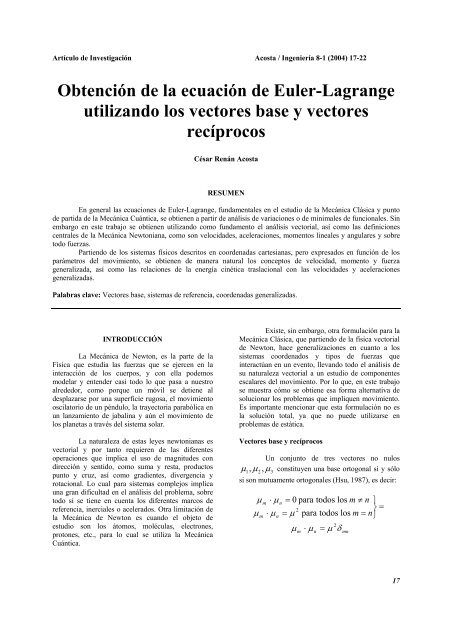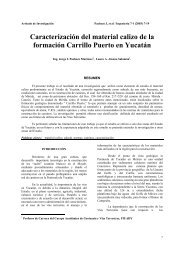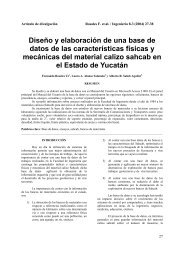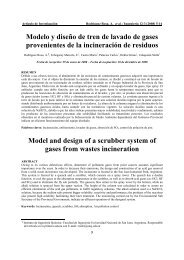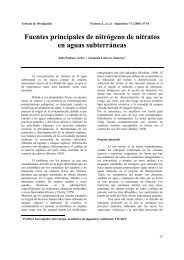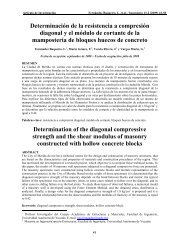Obtención de la ecuación de Euler-Lagrange utilizando los vectores ...
Obtención de la ecuación de Euler-Lagrange utilizando los vectores ...
Obtención de la ecuación de Euler-Lagrange utilizando los vectores ...
You also want an ePaper? Increase the reach of your titles
YUMPU automatically turns print PDFs into web optimized ePapers that Google loves.
Artículo <strong>de</strong> Investigación Acosta / Ingeniería 8-1 (2004) 17-22<br />
<strong>Obtención</strong> <strong>de</strong> <strong>la</strong> <strong>ecuación</strong> <strong>de</strong> <strong>Euler</strong>-<strong>Lagrange</strong><br />
<strong>utilizando</strong> <strong>los</strong> <strong>vectores</strong> base y <strong>vectores</strong><br />
recíprocos<br />
César Renán Acosta<br />
RESUMEN<br />
En general <strong>la</strong>s ecuaciones <strong>de</strong> <strong>Euler</strong>-<strong>Lagrange</strong>, fundamentales en el estudio <strong>de</strong> <strong>la</strong> Mecánica Clásica y punto<br />
<strong>de</strong> partida <strong>de</strong> <strong>la</strong> Mecánica Cuántica, se obtienen a partir <strong>de</strong> análisis <strong>de</strong> variaciones o <strong>de</strong> minimales <strong>de</strong> funcionales. Sin<br />
embargo en este trabajo se obtienen <strong>utilizando</strong> como fundamento el análisis vectorial, así como <strong>la</strong>s <strong>de</strong>finiciones<br />
centrales <strong>de</strong> <strong>la</strong> Mecánica Newtoniana, como son velocida<strong>de</strong>s, aceleraciones, momentos lineales y angu<strong>la</strong>res y sobre<br />
todo fuerzas.<br />
Partiendo <strong>de</strong> <strong>los</strong> sistemas físicos <strong>de</strong>scritos en coor<strong>de</strong>nadas cartesianas, pero expresados en función <strong>de</strong> <strong>los</strong><br />
parámetros <strong>de</strong>l movimiento, se obtienen <strong>de</strong> manera natural <strong>los</strong> conceptos <strong>de</strong> velocidad, momento y fuerza<br />
generalizada, así como <strong>la</strong>s re<strong>la</strong>ciones <strong>de</strong> <strong>la</strong> energía cinética tras<strong>la</strong>cional con <strong>la</strong>s velocida<strong>de</strong>s y aceleraciones<br />
generalizadas.<br />
Pa<strong>la</strong>bras c<strong>la</strong>ve: Vectores base, sistemas <strong>de</strong> referencia, coor<strong>de</strong>nadas generalizadas.<br />
INTRODUCCIÓN<br />
La Mecánica <strong>de</strong> Newton, es <strong>la</strong> parte <strong>de</strong> <strong>la</strong><br />
Física que estudia <strong>la</strong>s fuerzas que se ejercen en <strong>la</strong><br />
interacción <strong>de</strong> <strong>los</strong> cuerpos, y con el<strong>la</strong> po<strong>de</strong>mos<br />
mo<strong>de</strong><strong>la</strong>r y enten<strong>de</strong>r casi todo lo que pasa a nuestro<br />
alre<strong>de</strong>dor, como porque un móvil se <strong>de</strong>tiene al<br />
<strong>de</strong>sp<strong>la</strong>zarse por una superficie rugosa, el movimiento<br />
osci<strong>la</strong>torio <strong>de</strong> un péndulo, <strong>la</strong> trayectoria parabólica en<br />
un <strong>la</strong>nzamiento <strong>de</strong> jabalina y aún el movimiento <strong>de</strong><br />
<strong>los</strong> p<strong>la</strong>netas a través <strong>de</strong>l sistema so<strong>la</strong>r.<br />
La naturaleza <strong>de</strong> estas leyes newtonianas es<br />
vectorial y por tanto requieren <strong>de</strong> <strong>la</strong>s diferentes<br />
operaciones que implica el uso <strong>de</strong> magnitu<strong>de</strong>s con<br />
dirección y sentido, como suma y resta, productos<br />
punto y cruz, así como gradientes, divergencia y<br />
rotacional. Lo cual para sistemas complejos implica<br />
una gran dificultad en el análisis <strong>de</strong>l problema, sobre<br />
todo si se tiene en cuenta <strong>los</strong> diferentes marcos <strong>de</strong><br />
referencia, inerciales o acelerados. Otra limitación <strong>de</strong><br />
<strong>la</strong> Mecánica <strong>de</strong> Newton es cuando el objeto <strong>de</strong><br />
estudio son <strong>los</strong> átomos, molécu<strong>la</strong>s, electrones,<br />
protones, etc., para lo cual se utiliza <strong>la</strong> Mecánica<br />
Cuántica.<br />
Existe, sin embargo, otra formu<strong>la</strong>ción para <strong>la</strong><br />
Mecánica Clásica, que partiendo <strong>de</strong> <strong>la</strong> física vectorial<br />
<strong>de</strong> Newton, hace generalizaciones en cuanto a <strong>los</strong><br />
sistemas coor<strong>de</strong>nados y tipos <strong>de</strong> fuerzas que<br />
interactúan en un evento, llevando todo el análisis <strong>de</strong><br />
su naturaleza vectorial a un estudio <strong>de</strong> componentes<br />
esca<strong>la</strong>res <strong>de</strong>l movimiento. Por lo que, en este trabajo<br />
se muestra cómo se obtiene esa forma alternativa <strong>de</strong><br />
solucionar <strong>los</strong> problemas que impliquen movimiento.<br />
Es importante mencionar que esta formu<strong>la</strong>ción no es<br />
<strong>la</strong> solución total, ya que no pue<strong>de</strong> utilizarse en<br />
problemas <strong>de</strong> estática.<br />
Vectores base y recíprocos<br />
Un conjunto <strong>de</strong> tres <strong>vectores</strong> no nu<strong>los</strong><br />
µ 1 , µ 2,<br />
µ 3 constituyen una base ortogonal si y sólo<br />
si son mutuamente ortogonales (Hsu, 1987), es <strong>de</strong>cir:<br />
µ m ⋅ µ n = 0 para todos ,<br />
<strong>los</strong> m ≠ n ⎫<br />
2<br />
⎬ =<br />
µ m ⋅ µ n = µ para todos <strong>los</strong> m = n⎭<br />
2<br />
µ ⋅ µ = µ δ<br />
m<br />
n<br />
mn<br />
17
Artículo <strong>de</strong> Investigación Acosta / Ingeniería 8-1 (2004) 17-22<br />
don<strong>de</strong> δ mn es <strong>la</strong> <strong>de</strong>lta <strong>de</strong> Kronecker, y se tiene una<br />
base ortonormal si este conjunto <strong>de</strong> tres <strong>vectores</strong> es<br />
ˆ µ , ˆ µ , ˆ µ , es <strong>de</strong>cir:<br />
unitario 1 2 3<br />
⎧1si<br />
m = n<br />
ˆ<br />
⎫<br />
µ ⋅ ˆ<br />
m µ n = δ mn = ⎨ ⎬ .<br />
⎩0<br />
si m ≠ n⎭<br />
r<br />
Así, un vector cualquiera A se pue<strong>de</strong><br />
escribir en <strong>la</strong> dirección <strong>de</strong> su base <strong>de</strong> <strong>vectores</strong><br />
unitarios como:<br />
18<br />
A r<br />
+<br />
+<br />
= [ ( A ˆ 1µ<br />
1 + A ˆ 2µ<br />
2 + A ˆ 3µ<br />
3 ) ⋅ ˆ µ 1 ]<br />
[ ( A ˆ 1µ<br />
1 + A ˆ 2µ<br />
2 + A ˆ 3µ<br />
3 ) ⋅ ˆ µ 2 ] ˆ µ 2<br />
[ ( A ˆ ˆ ˆ<br />
1µ<br />
1 + A2µ<br />
2 + A3µ<br />
3 ) ⋅ ˆ µ 3 ] ˆ µ 3<br />
ˆ µ<br />
que <strong>de</strong> manera con<strong>de</strong>nsada es:<br />
r<br />
A =<br />
3 r<br />
A ⋅ ˆ µ ˆ µ . (1)<br />
∑<br />
i=<br />
1<br />
( i )<br />
Definiendo un sistema coor<strong>de</strong>nado, al cual<br />
l<strong>la</strong>maremos generalizado con representación<br />
q 1 , q2<br />
, q3<br />
. Las coor<strong>de</strong>nadas cartesianas son función<br />
<strong>de</strong> dichas coor<strong>de</strong>nadas generalizadas, esto es:<br />
x = x(<br />
q1,<br />
q2,<br />
q3<br />
); y = y(<br />
q1,<br />
q2<br />
, q3<br />
);<br />
z = z(<br />
q q , q );<br />
1,<br />
2 3<br />
Entonces, el vector <strong>de</strong> posición r r se pue<strong>de</strong><br />
expresar en función <strong>de</strong> <strong>los</strong> <strong>vectores</strong> unitarios <strong>de</strong><br />
coor<strong>de</strong>nadas cartesianas <strong>de</strong> <strong>la</strong> siguiente manera:<br />
r<br />
r = x<br />
( q q , q ) iˆ<br />
+ y(<br />
q , q , q ) ˆj<br />
+ z(<br />
q , q , q )k<br />
1 , 2 3<br />
1 2 3<br />
1 2 3<br />
.<br />
A partir <strong>de</strong> <strong>la</strong> <strong>de</strong>finición anterior se construye<br />
una nueva base <strong>de</strong> <strong>vectores</strong> como (Hsu, 1987):<br />
i<br />
r r<br />
∂r<br />
bi<br />
= , (2)<br />
∂q<br />
este vector base generalizado, en coor<strong>de</strong>nadas<br />
cartesianas es:<br />
r ∂x<br />
y z<br />
b iˆ<br />
∂ ˆ ∂<br />
i = + j + k<br />
ˆ<br />
, (3)<br />
∂q<br />
∂q<br />
∂q<br />
i<br />
i<br />
i<br />
i<br />
1<br />
ˆ<br />
como el vector anterior no es unitario, <strong>de</strong>beremos<br />
dividir entre su propia magnitud, <strong>la</strong> cual se conoce<br />
como coeficiente métrico o factor <strong>de</strong> esca<strong>la</strong>, y se<br />
representa por:<br />
r<br />
∂r<br />
hi<br />
= ,<br />
∂q<br />
por lo cual el vector unitario queda expresado como:<br />
i<br />
r<br />
b<br />
i<br />
eˆ<br />
i = . (4)<br />
hi<br />
Adicional a esta base existe otra que se<br />
conoce como <strong>la</strong> base recíproca cuyos <strong>vectores</strong> se<br />
representan por i cr , con <strong>la</strong> siguiente propiedad:<br />
r r<br />
c ⋅ = δ .<br />
i b j<br />
se observa que el vector i cr tiene <strong>la</strong> misma dirección<br />
r<br />
<strong>de</strong> bi<br />
pero sus magnitu<strong>de</strong>s son recíprocas:<br />
y en función <strong>de</strong> i b<br />
r<br />
es<br />
i<br />
ij<br />
1<br />
ci<br />
= eˆ<br />
i ,<br />
h<br />
r<br />
b<br />
ci<br />
=<br />
h<br />
, (5)<br />
i<br />
2<br />
i<br />
otra forma <strong>de</strong> escribir al vector recíproco es<br />
r ∂qi<br />
q q<br />
c iˆ<br />
∂ i ˆ ∂ i<br />
i = + j + k<br />
ˆ<br />
. (6)<br />
∂x<br />
∂y<br />
∂z<br />
Componente covariante y contravariante <strong>de</strong> <strong>la</strong><br />
velocidad<br />
Bajo <strong>la</strong> notación <strong>de</strong> <strong>vectores</strong> base y<br />
recíprocos, el vector velocidad se representa como:<br />
= v<br />
r<br />
3<br />
∑<br />
i=<br />
1<br />
r<br />
( ⋅ ˆ ) e v<br />
ˆ<br />
i i e<br />
es c<strong>la</strong>ro que el vector velocidad tiene dos formas<br />
equivalentes <strong>de</strong> escribirse, una en función <strong>de</strong> <strong>la</strong> base
Artículo <strong>de</strong> Investigación Acosta / Ingeniería 8-1 (2004) 17-22<br />
r<br />
bi<br />
y otra en función <strong>de</strong> <strong>la</strong> base recíproca ci r . La<br />
primera forma es:<br />
r<br />
v =<br />
⎛ r<br />
r r<br />
b ⎞ b<br />
r r<br />
( v ⋅ bi<br />
)<br />
3<br />
3<br />
⎜ i ⎟ i<br />
i<br />
∑ v ⋅ =<br />
⎜ ⎟ ∑<br />
2<br />
i= 1 hi<br />
hi<br />
i= 1 hi<br />
⎝<br />
⎠<br />
r<br />
b , (7)<br />
obteniendo el producto punto <strong>de</strong> <strong>los</strong> <strong>vectores</strong><br />
velocidad y base. Tomando en cuenta <strong>la</strong> <strong>ecuación</strong> (5),<br />
<strong>la</strong> velocidad es (Hausser, 1969):<br />
= v<br />
r<br />
3<br />
∑<br />
i=<br />
1<br />
( ⋅ ) b v<br />
r r<br />
ˆ<br />
i i c<br />
, (8)<br />
el término entre paréntesis es una componente<br />
r<br />
vectorial <strong>de</strong> <strong>la</strong> velocidad en <strong>la</strong> dirección <strong>de</strong> bi<br />
, pero<br />
se encuentra <strong>de</strong>finida ahora en función <strong>de</strong> <strong>la</strong>s<br />
coor<strong>de</strong>nadas generalizadas q 1 , q2<br />
, q3<br />
y se le conoce<br />
como <strong>la</strong> componente covariante <strong>de</strong> <strong>la</strong> velocidad, es<br />
<strong>de</strong>cir:<br />
en coor<strong>de</strong>nadas cartesianas es:<br />
r r<br />
v = v ⋅ b , (9)<br />
i<br />
i<br />
( ) ⎟ ⎛ ∂x<br />
∂y<br />
∂z<br />
⎞<br />
v iˆ<br />
+ v ˆj<br />
+ v k<br />
ˆ<br />
⋅⎜<br />
iˆ<br />
+ ˆj<br />
+<br />
ˆ<br />
1 2 3<br />
vi<br />
=<br />
⎜<br />
k .<br />
⎝ ∂qi<br />
∂qi<br />
∂qi<br />
⎠<br />
Realizando el producto punto y sustituyendo<br />
v 1 , v2<br />
, v3<br />
por x& , y&<br />
, z&<br />
nos queda <strong>la</strong> componente<br />
covariante <strong>de</strong> <strong>la</strong> velocidad como:<br />
∂x<br />
∂y<br />
∂z<br />
vi<br />
= x&<br />
+ y&<br />
+ z&<br />
(10)<br />
∂q<br />
∂q<br />
∂q<br />
i<br />
i<br />
observemos que <strong>la</strong>s coor<strong>de</strong>nadas cartesianas x , y,<br />
z<br />
son funciones <strong>de</strong> <strong>la</strong>s coor<strong>de</strong>nadas generalizadas<br />
q 1 , q2<br />
, q3<br />
, pero no son funciones explícitas <strong>de</strong>l<br />
tiempo. Por lo que si <strong>de</strong>rivamos cualquiera <strong>de</strong> el<strong>la</strong>s<br />
respecto <strong>de</strong> t, aplicando <strong>la</strong> reg<strong>la</strong> <strong>de</strong> <strong>la</strong> ca<strong>de</strong>na, se<br />
obtiene:<br />
dx<br />
dt<br />
∂x<br />
dq<br />
∑ ∂q<br />
= i<br />
i<br />
i<br />
i dt<br />
es <strong>de</strong>cir que <strong>la</strong> velocidad en coor<strong>de</strong>nadas<br />
generalizadas es:<br />
,<br />
x&<br />
∂x<br />
∑ q&<br />
i<br />
∂q<br />
= i<br />
po<strong>de</strong>mos ver que el término <strong>de</strong> <strong>la</strong> <strong>de</strong>rivada parcial <strong>de</strong><br />
x, <strong>de</strong>pen<strong>de</strong> <strong>de</strong> <strong>la</strong>s coor<strong>de</strong>nadas generalizadas, pero no<br />
<strong>de</strong> <strong>la</strong>s velocida<strong>de</strong>s generalizadas i q& , entonces, si<br />
<strong>de</strong>rivamos parcialmente respecto <strong>de</strong> estas velocida<strong>de</strong>s<br />
generalizadas, se obtiene:<br />
i<br />
i<br />
i<br />
∂x&<br />
∂x<br />
= , (11)<br />
∂q&<br />
∂q<br />
sustituyendo <strong>la</strong> ec. (11) en <strong>la</strong> componente covariante<br />
<strong>de</strong> <strong>la</strong> velocidad, ec. (10):<br />
x&<br />
y&<br />
z&<br />
vi<br />
x&<br />
∂<br />
y&<br />
∂<br />
z&<br />
∂<br />
= + + , (12)<br />
∂q&<br />
∂q&<br />
∂q&<br />
i<br />
i<br />
<strong>la</strong> cual po<strong>de</strong>mos factorizar como un producto punto<br />
<strong>de</strong> <strong>la</strong> siguiente manera:<br />
r<br />
r ∂v<br />
vi<br />
= v ⋅ .<br />
∂q&<br />
Para obtener una re<strong>la</strong>ción equivalente<br />
<strong>de</strong>rivemos parcialmente el producto punto <strong>de</strong>l vector<br />
velocidad por si mismo, respecto <strong>de</strong> <strong>la</strong> coor<strong>de</strong>nada<br />
generalizada q&<br />
i :<br />
r r r r<br />
∂(<br />
v ⋅v<br />
) ∂v<br />
r r ∂v<br />
= ⋅v<br />
+ v ⋅ ,<br />
∂q&<br />
∂q&<br />
∂q&<br />
i<br />
i<br />
al ser el producto punto conmutativo, <strong>los</strong> dos<br />
términos son iguales, a<strong>de</strong>más <strong>de</strong> que el producto<br />
esca<strong>la</strong>r <strong>de</strong> un vector por si mismo es el vector elevado<br />
al cuadrado:<br />
i<br />
i<br />
r<br />
r ∂v<br />
∂ ⎛ 1 2 ⎞<br />
v ⋅ = ⎜ v ⎟ , (13)<br />
∂q&<br />
∂q&<br />
⎝ 2 ⎠<br />
i<br />
así, <strong>la</strong> componente covariante <strong>de</strong> <strong>la</strong> velocidad se<br />
pue<strong>de</strong> escribir como (Hausser, 1969):<br />
i<br />
∂ ⎛ 1 2 ⎞<br />
vi<br />
= ⎜ v ⎟ , (14)<br />
∂q&<br />
⎝ 2 ⎠<br />
i<br />
i<br />
19
Artículo <strong>de</strong> Investigación Acosta / Ingeniería 8-1 (2004) 17-22<br />
si multiplicamos ambos <strong>la</strong>dos <strong>de</strong> <strong>la</strong> igualdad por <strong>la</strong><br />
masa nos queda, en el <strong>la</strong>do izquierdo el momento<br />
generalizado y en el <strong>la</strong>do <strong>de</strong>recho <strong>la</strong> <strong>de</strong>rivada parcial<br />
<strong>de</strong> <strong>la</strong> energía cinética respecto <strong>de</strong> <strong>la</strong> velocidad<br />
generalizada:<br />
20<br />
∂ ⎛ 1 2 ⎞<br />
mvi<br />
= ⎜ mv ⎟ , (15)<br />
∂q&<br />
⎝ 2 ⎠<br />
i<br />
lo cual nos muestra una metodología <strong>de</strong> solución <strong>de</strong><br />
<strong>los</strong> problemas <strong>de</strong> mecánica en cualquier sistema <strong>de</strong><br />
coor<strong>de</strong>nadas, partiendo <strong>de</strong> una <strong>de</strong>scripción en<br />
coor<strong>de</strong>nadas cartesianas, ya que <strong>la</strong> magnitud <strong>de</strong> <strong>la</strong><br />
velocidad total es:<br />
r<br />
v<br />
&<br />
2 2 2<br />
= x + y + z ,<br />
&<br />
el método opera <strong>de</strong> <strong>la</strong> siguiente manera, se <strong>de</strong>scribe el<br />
movimiento <strong>de</strong> <strong>los</strong> objetos que interactúan en un<br />
momento t cualquiera a partir <strong>de</strong> sistema <strong>de</strong><br />
coor<strong>de</strong>nadas cartesianas fijo. Se <strong>de</strong>rivan <strong>la</strong>s<br />
componentes cartesianas respecto <strong>de</strong>l tiempo y<br />
finalmente <strong>la</strong> magnitud <strong>de</strong> <strong>la</strong> velocidad es <strong>la</strong> suma <strong>de</strong><br />
estas <strong>de</strong>rivadas elevadas al cuadrado. De esta<br />
<strong>de</strong>scripción se obtienen <strong>la</strong>s coor<strong>de</strong>nadas<br />
generalizadas, que serán <strong>los</strong> parámetros <strong>de</strong>l<br />
movimiento. Al multiplicar esta velocidad<br />
generalizada por <strong>la</strong> masa, nos quedan <strong>los</strong> momentos<br />
generalizados.<br />
Si modificamos <strong>la</strong> ec. (5), insertando el<br />
factor <strong>de</strong> esca<strong>la</strong>, <strong>de</strong>ntro <strong>de</strong>l paréntesis, se obtiene:<br />
∑= ⎟ ⎟<br />
r<br />
3 r ⎛ ⎞<br />
⎜<br />
r b r<br />
i<br />
v = v ⋅ b , (16)<br />
⎜ 2 i<br />
i 1 ⎝ hi<br />
⎠<br />
en <strong>la</strong> que el producto punto está ahora en función <strong>de</strong>l<br />
vector recíproco, el cual se conoce como <strong>la</strong><br />
componente contravariante <strong>de</strong>l vector velocidad, esta<br />
componente se representa por:<br />
v<br />
*<br />
i<br />
i<br />
&<br />
r r<br />
= v ⋅ c , (17)<br />
siguiendo el mismo procedimiento que en <strong>la</strong><br />
componente covariante, se obtiene:<br />
v<br />
*<br />
i<br />
∂qi<br />
∂qi<br />
∂qi<br />
= x&<br />
+ y&<br />
+ z&<br />
, (18)<br />
∂x<br />
∂y<br />
∂y<br />
escribiendo <strong>la</strong>s velocida<strong>de</strong>s en coor<strong>de</strong>nadas<br />
cartesianas, como <strong>de</strong>rivadas parciales:<br />
v<br />
*<br />
i<br />
∂x<br />
∂qi<br />
∂y<br />
∂qi<br />
∂z<br />
∂qi<br />
= + + , (19)<br />
∂t<br />
∂x<br />
∂t<br />
∂y<br />
∂t<br />
∂y<br />
se pue<strong>de</strong> ver que esto es so<strong>la</strong>mente <strong>la</strong> aplicación <strong>de</strong> <strong>la</strong><br />
reg<strong>la</strong> <strong>de</strong> <strong>la</strong> ca<strong>de</strong>na, por lo que se escribe como:<br />
v<br />
*<br />
i<br />
= q&<br />
, (20)<br />
es <strong>de</strong>cir que <strong>la</strong> componente contravariante <strong>de</strong> <strong>la</strong><br />
velocidad es <strong>la</strong> velocidad generalizada (Hausser,<br />
1969).<br />
4 Aceleraciones covariantes, contravariantes y<br />
fuerzas generalizadas<br />
De <strong>la</strong> misma manera que con <strong>la</strong> velocidad se<br />
obtienen <strong>la</strong>s componentes contravariante y covariante,<br />
obtenemos para <strong>la</strong> aceleración,<br />
a<br />
*<br />
i<br />
∂qi<br />
∂qi<br />
∂qi<br />
= &x<br />
& + &y<br />
& + &z<br />
& ,<br />
∂x<br />
∂y<br />
∂z<br />
en <strong>la</strong> que si tomamos el resultado <strong>de</strong> <strong>la</strong> ec. (11), se<br />
expresa como:<br />
x&<br />
q&<br />
i y&<br />
q&<br />
i z q&<br />
* ∂ ∂ ∂ ∂ ∂&<br />
∂ i<br />
ai<br />
= + + = q&<br />
&<br />
i ,<br />
∂t<br />
∂x&<br />
∂t<br />
∂y&<br />
∂t<br />
∂z&<br />
es <strong>de</strong>cir, <strong>la</strong> aceleración contravariante es igual a <strong>la</strong><br />
aceleración generalizada. Para <strong>la</strong> aceleración<br />
covariante se tiene:<br />
∂x<br />
∂y<br />
∂z<br />
ai<br />
= & x&<br />
+ &y<br />
& + &z<br />
& , (21)<br />
∂qi<br />
∂qi<br />
∂qi<br />
haciendo <strong>la</strong> <strong>de</strong>rivada respecto <strong>de</strong>l tiempo <strong>de</strong> <strong>la</strong><br />
coor<strong>de</strong>nada cartesiana x, y generalizando a <strong>la</strong>s otras<br />
coor<strong>de</strong>nadas.<br />
d<br />
dt<br />
i<br />
⎛ ∂x<br />
⎞ ∂x<br />
d ⎛ ∂x<br />
⎞<br />
⎜ x&<br />
⎟ = &x<br />
& + x&<br />
⎜<br />
⎟ , (22)<br />
⎝ ∂qi<br />
⎠ ∂qi<br />
dt ⎝ ∂qi<br />
⎠<br />
<strong>de</strong>spejando <strong>la</strong> ec. (22) y sustituyendo el resultado<br />
obtenido en <strong>la</strong> ec. (11), se obtiene:<br />
∂x<br />
d ⎛ ∂x&<br />
⎞ ∂x&<br />
& x&<br />
= x − x<br />
qi<br />
dt ⎜ &<br />
q ⎟ & . (23)<br />
∂ ⎝ ∂ &<br />
i ⎠ ∂qi
Artículo <strong>de</strong> Investigación Acosta / Ingeniería 8-1 (2004) 17-22<br />
Agrupando <strong>los</strong> términos <strong>de</strong> <strong>la</strong> aceleración<br />
covariante,<br />
a<br />
i<br />
d ⎛ ∂x&<br />
∂y&<br />
∂z&<br />
⎞<br />
=<br />
⎜ x&<br />
+ y&<br />
+ z&<br />
⎟ −<br />
dt ⎝ ∂q&<br />
i ∂q&<br />
i ∂q&<br />
i ⎠<br />
. (24)<br />
⎛ ∂x&<br />
∂y&<br />
∂z&<br />
⎞<br />
⎜ x&<br />
+ y&<br />
+ z&<br />
⎟<br />
⎝ ∂qi<br />
∂qi<br />
∂qi<br />
⎠<br />
Hagamos <strong>la</strong> <strong>de</strong>rivada parcial <strong>de</strong>l producto<br />
punto <strong>de</strong>l vector velocidad por si mismo, respecto <strong>de</strong><br />
<strong>la</strong> coor<strong>de</strong>nada generalizada q i :<br />
r r<br />
∂<br />
∂q<br />
( v ⋅v<br />
)<br />
i<br />
r r<br />
∂v<br />
r r ∂v<br />
= ⋅v<br />
+ v ⋅ , (25)<br />
∂q<br />
∂q<br />
en <strong>la</strong> que <strong>la</strong> ec. (25) se simplifica como:<br />
i<br />
r<br />
r ∂v<br />
v ⋅<br />
∂q<br />
i<br />
=<br />
∂<br />
∂q<br />
i<br />
i<br />
⎛ 1<br />
⎜ v<br />
⎝ 2<br />
2<br />
⎞<br />
⎟ , (26)<br />
⎠<br />
sustituyendo en <strong>la</strong> ec. (24), y <strong>utilizando</strong> el resultado<br />
obtenido en <strong>la</strong> ec. (13),<br />
d ⎡ ∂ ⎛ 1 2 ⎞⎤<br />
∂ ⎛ 1 2 ⎞<br />
ai<br />
= ⎢ ⎜ v ⎟⎥<br />
− ⎜ v ⎟ , (27)<br />
dt ⎣∂q&<br />
i ⎝ 2 ⎠⎦<br />
∂qi<br />
⎝ 2 ⎠<br />
así, <strong>la</strong> aceleración covariante queda expresada en<br />
función <strong>de</strong> <strong>la</strong> velocidad total (Hausser, 1969). Si<br />
a<strong>de</strong>más multiplicamos ambos <strong>la</strong>dos <strong>de</strong> <strong>la</strong> igualdad por<br />
<strong>la</strong> masa, en el <strong>la</strong>do izquierdo nos queda <strong>la</strong> fuerza<br />
covariante o generalizada, y en el <strong>la</strong>do <strong>de</strong>recho una<br />
expresión que <strong>de</strong>pen<strong>de</strong> <strong>de</strong> <strong>la</strong> energía cinética<br />
tras<strong>la</strong>cional (T).<br />
F<br />
i<br />
=<br />
d<br />
dt<br />
⎛ ∂T<br />
⎞ ∂T<br />
⎜ −<br />
q ⎟ . (28)<br />
⎝ ∂ &<br />
i ⎠ ∂qi<br />
Escribamos <strong>la</strong> componente covariante <strong>de</strong> <strong>la</strong><br />
fuerza, como el producto punto <strong>de</strong>l vector fuerza y el<br />
r<br />
vector base bi<br />
:<br />
r r<br />
F = F ⋅b<br />
, (29)<br />
i<br />
i<br />
si ahora expresamos <strong>la</strong> fuerza como menos el<br />
gradiente <strong>de</strong> <strong>la</strong> energía potencial (U):<br />
⎛ ∂U<br />
∂U<br />
∂U<br />
⎞<br />
F = −⎜<br />
iˆ<br />
+ ˆj<br />
+ kˆ<br />
i<br />
⎟ ⋅<br />
⎝ ∂x<br />
∂y<br />
∂z<br />
⎠<br />
, (30)<br />
⎛ ∂x<br />
∂y<br />
∂z<br />
⎞<br />
⎜ iˆ<br />
+ ˆj<br />
+ kˆ<br />
⎟<br />
⎝ ∂qi<br />
∂qi<br />
∂qi<br />
⎠<br />
lo que muestra que <strong>la</strong> componente covariante <strong>de</strong> <strong>la</strong><br />
fuerza es menos <strong>la</strong> <strong>de</strong>rivada parcial <strong>de</strong> <strong>la</strong> energía<br />
potencial respecto <strong>de</strong> <strong>la</strong> coor<strong>de</strong>nada generalizada q i :<br />
∂U<br />
Fi<br />
= − . (31)<br />
∂q<br />
Si ponemos <strong>la</strong> condición <strong>de</strong> que se utilicen<br />
solo fuerzas conservativas, es <strong>de</strong>cir fuerzas que<br />
<strong>de</strong>pen<strong>de</strong>n únicamente <strong>de</strong> <strong>la</strong> posición o coor<strong>de</strong>nada<br />
generalizada U = U ( qi<br />
) , entonces si <strong>de</strong>rivamos<br />
parcialmente <strong>la</strong> energía potencial respecto <strong>de</strong> <strong>la</strong>s<br />
velocida<strong>de</strong>s generalizadas, se obtiene:<br />
∂U<br />
∂q&<br />
i<br />
( qi<br />
)<br />
= 0<br />
i<br />
, (32)<br />
rescribiendo <strong>la</strong> ec. (28) tomando en cuenta <strong>la</strong> ec. (31),<br />
∂U<br />
− =<br />
∂q<br />
i<br />
d<br />
dt<br />
organizando <strong>los</strong> términos en (33),<br />
d<br />
dt<br />
⎛ ∂T<br />
⎞ ∂T<br />
⎜ −<br />
q ⎟ , (33)<br />
⎝ ∂ &<br />
i ⎠ ∂qi<br />
( T −U<br />
)<br />
⎛ ∂T<br />
⎞ ∂<br />
⎜<br />
⎟ −<br />
⎝ ∂q&<br />
i ⎠ ∂qi<br />
= 0 , (34)<br />
si en <strong>la</strong> parte que correspon<strong>de</strong> a <strong>la</strong> <strong>de</strong>rivada respecto<br />
<strong>de</strong> <strong>la</strong> velocidad generalizada sustituimos el resultado<br />
obtenido en <strong>la</strong> ec. (32), el resultado no cambia.<br />
d ⎛ ∂<br />
⎜<br />
dt ⎝ ∂q&<br />
i<br />
( T −U<br />
) ⎞ ∂(<br />
T −U<br />
)<br />
⎟ −<br />
⎠<br />
∂q<br />
i<br />
= 0 , (35)<br />
si ahora l<strong>la</strong>mamos L = T −U<br />
, al termino <strong>de</strong> <strong>la</strong><br />
diferencia <strong>de</strong> energías, se obtiene <strong>la</strong> <strong>ecuación</strong> <strong>de</strong><br />
<strong>Euler</strong>-<strong>Lagrange</strong> (Hausser, 1969; Marion, 1992;<br />
21
Artículo <strong>de</strong> Investigación Acosta / Ingeniería 8-1 (2004) 17-22<br />
Barger et al 1973; Simon 1971; Landau et al, 1982;<br />
Goldstein 1990 ), <strong>la</strong> cual es:<br />
22<br />
d<br />
dt<br />
⎛ ∂L<br />
⎞ ∂L<br />
⎜<br />
⎟ − = 0 . (36)<br />
⎝ ∂q&<br />
i ⎠ ∂qi<br />
Esta <strong>ecuación</strong>, tiene <strong>la</strong> restricción <strong>de</strong> que<br />
sólo se pue<strong>de</strong> aplicar a fuerzas conservativas, ya que<br />
así se incluyó <strong>la</strong> parcial <strong>de</strong> <strong>la</strong> energía potencial<br />
respecto <strong>de</strong> <strong>la</strong> velocidad generalizada. Si existen<br />
pérdidas éstas se reflejan igua<strong>la</strong>ndo <strong>la</strong> <strong>ecuación</strong> <strong>de</strong><br />
<strong>Euler</strong>-<strong>Lagrange</strong> a Q i , don<strong>de</strong> Q i representa <strong>la</strong> suma<br />
<strong>de</strong> todas <strong>la</strong>s fuerzas no conservativas (Hausser, 1969;<br />
Marion, 1992; Barger et al 1973; Simon 1971;<br />
Landau et al, 1982; Goldstein 1990 ).<br />
d<br />
dt<br />
Comentarios finales<br />
⎛ ∂L<br />
⎞ ∂L<br />
⎜ − = Qi<br />
q ⎟<br />
⎝ ∂ &<br />
i ⎠ ∂qi<br />
(37)<br />
Las ecuaciones (36) y (37) se conocen como<br />
ecuaciones <strong>de</strong> movimiento <strong>de</strong> <strong>Lagrange</strong> y a <strong>la</strong><br />
diferencia entre <strong>la</strong> energía cinética y <strong>la</strong> energía<br />
potencial, se le conoce como <strong>la</strong> <strong>la</strong>grangiana. La<br />
importancia <strong>de</strong> estas ecuaciones es enorme, ya que<br />
BIBLIOGRAFÍA<br />
simplifican <strong>la</strong> aplicación <strong>de</strong> <strong>la</strong> física a sistemas<br />
complejos, y son punto <strong>de</strong> partida <strong>de</strong> <strong>la</strong> Mecánica<br />
Cuántica.<br />
Se muestra en este <strong>de</strong>sarrollo, que <strong>la</strong><br />
obtención <strong>de</strong> <strong>la</strong>s ecuaciones <strong>de</strong> <strong>Euler</strong>-<strong>Lagrange</strong> son<br />
consecuencia <strong>de</strong> <strong>la</strong>s ecuaciones <strong>de</strong> Newton, y que se<br />
pue<strong>de</strong>n obtener sin utilizar el concepto <strong>de</strong>l funcional,<br />
y sin requerir <strong>la</strong> minimización <strong>de</strong> estos, que sin<br />
embargo lleva a <strong>la</strong> conceptualización <strong>de</strong> que si un<br />
sistema está en equilibrio dinámico, entonces tiene su<br />
mínima energía. Esta situación se pone <strong>de</strong> manifiesto<br />
en este procedimiento, al exigir que <strong>la</strong> energía<br />
potencial sea solo función <strong>de</strong> <strong>la</strong> posición y no <strong>de</strong> <strong>la</strong><br />
velocidad generalizada.<br />
La aplicación <strong>de</strong> <strong>la</strong> <strong>ecuación</strong> <strong>de</strong> <strong>Euler</strong>-<br />
<strong>Lagrange</strong>, tiene ventajas operativas sobre <strong>la</strong>s<br />
ecuaciones vectoriales <strong>de</strong> Newton, ya que al<br />
aplicar<strong>la</strong>s para cada coor<strong>de</strong>nada generalizada, nos da<br />
como resultado un sistema <strong>de</strong> ecuaciones<br />
diferenciales, cuya solución nos expresa todas <strong>la</strong>s<br />
fuerzas generalizadas que interactúan. Otra ventaja es<br />
que <strong>la</strong> conservación <strong>de</strong>l momento generalizado se<br />
pue<strong>de</strong> verificar únicamente, checando <strong>la</strong>s<br />
<strong>de</strong>pen<strong>de</strong>ncias <strong>de</strong> <strong>la</strong> función <strong>de</strong> energía cinética, ya que<br />
si una función tiene <strong>de</strong>pen<strong>de</strong>ncia <strong>de</strong> <strong>la</strong>s velocida<strong>de</strong>s<br />
generalizadas, pero no <strong>de</strong> <strong>la</strong> posición, existirá<br />
conservación <strong>de</strong> momentum, como se pue<strong>de</strong> ver en <strong>la</strong><br />
ec. (36).<br />
1) Hwei P. Hsu, (1987); “Análisis vectorial”, Addison-Wesley Iberoamaericana (De<strong>la</strong>ware), pp. 21-38.<br />
2) Hausser W. (1969); “Introducción a <strong>los</strong> principios <strong>de</strong> mecánica”, Uteha, (México), pp. 37-58, 65-82, 187-<br />
167.<br />
3) Marion B. J. (1992), “Dinámica clásica <strong>de</strong> <strong>la</strong>s partícu<strong>la</strong>s y sistemas”, 4ª edición, Reverté, (España) pp. 201-<br />
267.<br />
4) Barger V. & Olson M. (1973) “C<strong>la</strong>ssical mechanics”, McGraw-Hill (New York), pp. 31-75.<br />
5) Simon K. R. (1971), “Mechanics” 3 a edición, Addison-Wesley (Filipinas), pp. 353-395.<br />
6) Landau L. y Lifshitz E. (1982) “Mecánica y Electrodinámica” Mir (Moscú), pp. 11-20.<br />
7) Goldstein H. (1990), “Mecánica clásica”, Reverté (Barcelona), pp. 43-66.


